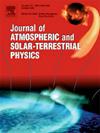Long-term projections of global, northern hemisphere, and arctic sea ice concentration using statistical and deep learning approaches
IF 1.9
4区 地球科学
Q3 GEOCHEMISTRY & GEOPHYSICS
Journal of Atmospheric and Solar-Terrestrial Physics
Pub Date : 2025-09-20
DOI:10.1016/j.jastp.2025.106634
引用次数: 0
Abstract
The accelerating decline in sea ice concentration (SIC) poses significant challenges for global climate regulation, maritime navigation, and arctic ecosystem stability. This study develops and evaluates two advanced time-series forecasting models, seasonal autoregressive integrated moving average (SARIMA) and long short-term memory (LSTM) networks, to project SIC trends through 2050 across three spatial domains: the globe, the northern hemisphere, and the arctic. Utilizing the ERA5 reanalysis dataset (1970–2024) from the European center for medium-range weather forecasts (ECMWF), the models capture seasonal cycles and complex temporal dependencies to enable robust long-term projections. Comparative analysis demonstrates that SARIMA effectively models periodic fluctuations, while LSTM excels at learning nonlinear dependencies inherent in SIC dynamics. Performance metrics, including mean absolute percentage error (MAPE), root mean square error (RMSE), and correlation coefficient (R), confirm the high accuracy of both models, with SARIMA showing superior capability in representing structured seasonal patterns. Projections indicate a persistent decline in SIC, with arctic concentrations decreasing from 55.60% in 2023 to approximately 46.84% by 2050, underscoring the pronounced effects of arctic amplification. These results provide valuable insights for climate modeling, arctic policy formulation, and the development of adaptive navigation strategies in a rapidly changing polar environment.
使用统计和深度学习方法的全球、北半球和北极海冰浓度的长期预测
海冰浓度的加速下降对全球气候调节、海上航行和北极生态系统的稳定提出了重大挑战。本研究开发并评估了两个先进的时间序列预测模型,即季节自回归综合移动平均(SARIMA)和长短期记忆(LSTM)网络,以预测到2050年全球、北半球和北极三个空间域的SIC趋势。利用欧洲中期天气预报中心(ECMWF)的ERA5再分析数据集(1970-2024),这些模式捕捉季节周期和复杂的时间依赖性,从而实现可靠的长期预测。对比分析表明,SARIMA有效地模拟了周期波动,而LSTM在学习SIC动力学中固有的非线性依赖方面表现出色。包括平均绝对百分比误差(MAPE)、均方根误差(RMSE)和相关系数(R)在内的性能指标证实了两种模型的高准确性,其中SARIMA在表示结构化季节模式方面表现出卓越的能力。预估表明SIC持续下降,北极浓度从2023年的55.60%下降到2050年的约46.84%,强调了北极放大的显著影响。这些结果为气候建模、北极政策制定以及在快速变化的极地环境中自适应导航策略的发展提供了有价值的见解。
本文章由计算机程序翻译,如有差异,请以英文原文为准。
求助全文
约1分钟内获得全文
求助全文
来源期刊

Journal of Atmospheric and Solar-Terrestrial Physics
地学-地球化学与地球物理
CiteScore
4.10
自引率
5.30%
发文量
95
审稿时长
6 months
期刊介绍:
The Journal of Atmospheric and Solar-Terrestrial Physics (JASTP) is an international journal concerned with the inter-disciplinary science of the Earth''s atmospheric and space environment, especially the highly varied and highly variable physical phenomena that occur in this natural laboratory and the processes that couple them.
The journal covers the physical processes operating in the troposphere, stratosphere, mesosphere, thermosphere, ionosphere, magnetosphere, the Sun, interplanetary medium, and heliosphere. Phenomena occurring in other "spheres", solar influences on climate, and supporting laboratory measurements are also considered. The journal deals especially with the coupling between the different regions.
Solar flares, coronal mass ejections, and other energetic events on the Sun create interesting and important perturbations in the near-Earth space environment. The physics of such "space weather" is central to the Journal of Atmospheric and Solar-Terrestrial Physics and the journal welcomes papers that lead in the direction of a predictive understanding of the coupled system. Regarding the upper atmosphere, the subjects of aeronomy, geomagnetism and geoelectricity, auroral phenomena, radio wave propagation, and plasma instabilities, are examples within the broad field of solar-terrestrial physics which emphasise the energy exchange between the solar wind, the magnetospheric and ionospheric plasmas, and the neutral gas. In the lower atmosphere, topics covered range from mesoscale to global scale dynamics, to atmospheric electricity, lightning and its effects, and to anthropogenic changes.
 求助内容:
求助内容: 应助结果提醒方式:
应助结果提醒方式:


